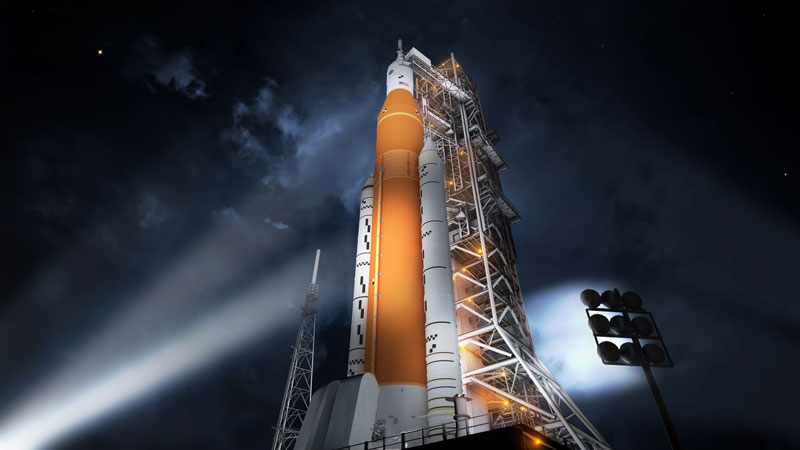NASA Boeing Space Launch System (SLS)
The Space Launch System (SLS) is NASA’s new big rocket, designed to have the capability to send humans to the Moon, Mars and beyond.
Even today, almost fifty years since it last flew, the Saturn V (which was used to send the Apollo missions to the Moon), remains the most powerful rocket ever built. Now at last there are some new rocket designs which provide the prospect of surpassing this mighty leviathan of human space flight. SpaceX’s Big Falcon Rocket (BFR) is on the drawing board, and prototype engines are under testing, but it is NASA’s SLS which looks closest to actual launch.
Gone are the days though, when NASA had the funding and resources to design and build rockets all by itself. Today, its major projects are operated in partnership with private corporations. For the SLS, the American aerospace giant Boeing is the preferred contractor. It is responsible for the design, development, testing and manufacture of the core stage of the launch vehicle, which provides the majority of power to the rocket. Boeing is also responsible for the development of the computer software used to stabilise, steer and fly the rocket.

History and Development of the Space Launch System
The SLS was originally envisaged as a replacement for the retired Space Shuttle. It was intended as a vehicle which could be used to send astronauts and supplies to the International Space Station (ISS) and, in the longer term, beyond Earth orbit.
Its design and future construction was first proposed by the US Congress as part of the terms of the 2010 NASA Authorisation Act. This mandated NASA to develop a single launch rocket which could be used to send cargo, satellites and human crew into space. It was intended to be able to lift heavy payloads, effectively also acting as a replacement for the long retired Saturn V too.
Progress from this point was slow and subject to constant public and political scrutiny. Cost overruns and developmental delays were a constant theme. Nevertheless, by the summer of 2014, prototypes had passed several key milestones, and Congress authorised full development and construction of the SLS.
The advent of the Trump presidency saw a change in the Federal government’s strategy for NASA. The President proposed that state funding for NASA was to be focused on deep space missions such as to the Moon and Mars. Near Earth space missions, such as supplying the ISS and satellite launches were to be handled predominantly by private space companies such as SpaceX and Blue Origin under these plans.
This change in the US government’s long term vision for NASA caused some alterations in the development plans for the SLS. Some of its original purposes were now to be left to the commercial space sector. This meant that some of the proposed variants of the rocket were abandoned, although the core components of the design were to remain the same.
However, an increase in funding was authorised for the crew carrying components of the SLS. This suggested that the long term prospects of the SLS as a deep space launch vehicle was secure. This additional funding was also intended to be used for the design and development of a lunar lander – again suggesting that the President was sincere in his commitment to funding future missions to the Moon and Mars.
Construction and Characteristics of the SLS
The SLS is still under development, so its final format remains unclear. Some parts of the launch system remain subject to revision, particularly the payload sections. Originally, three different configurations were planned, but at the time of writing it seems that the current focus is on the crew carrying functions and capacities of the rocket.
The core stage, which is being designed and developed by Boeing, seems to be pretty well settled. It will form the central, main part of the first stage of the rocket, which provides the power for lift off and the majority of the thrust necessary to propel the SLS into orbit. The core consists of four RS 25 engines, which are basically the same as those used to power the Space Shuttle. These will be powered by liquid hydrogen and liquid oxygen propellant.
The central core stage will be supported by a pair of Solid Rocket Boosters (SRBs), which will be strapped either side of the rocket. These too are similar and of the same basic design as those used on the Space Shuttle. They will be slightly taller, with five sections rather than the four used on the Shuttle. This extra capacity will give the boosters around 25% more power than those used on the Shuttle. The boosters will provide two minutes of additional power to the SLS, and supply around 75% of total thrust at lift off. The core stage rockets will be powered up once the SRBs are exhausted.
This first stage alone will be 212 feet tall, and will be 27.6 feet in diameter. It will weigh around 2.3 million lbs when fully loaded with fuel. It is planned to be the world’s most powerful rocket ever, reaching a maximum speed of more than 17,000 mph (Mach 23) in less than nine minutes.
It is intended that the first stage of the SLS will take the rocket most of the way to low Earth orbit (LEO). The Upper Stage will then take over for the final push. This will consist of four RL-10 engines, manufactured by Aerojet Rocketdyne. These will also burn liquid hydrogen and oxygen propellant. Each rocket can supply around 25,000 lb force, giving a total thrust of just under 100,000 lbf.
The upper stage will also be responsible for sending its crew or payload into higher Earth orbits or toward the Moon or Mars. It will be re-fired once it is safely in LEO, to provide the power to leave Earth’s gravity if and when required.
What will the SLS be used for?
The SLS will be capable of carrying a range of different payloads. It will have the capacity to lift very heavy loads – up to 290,000 lbs to LEO. This could in theory consist of cargo, satellites for insertion into orbit, or indeed a human crew.
However, the current strategy appears to be focused on the crew carrying function of the rocket, with private sector alternatives such as SpaceX’s BFR expected to take on much of the satellite and cargo carrying requirements.
The crew carrying module proposed for the SLS is the Orion spacecraft. This is a joint project between NASA, the American defence and aerospace manufacturer Lockheed Martin and the European Space Agency (ESA). It will be designed to carry a crew of four astronauts to LEO and beyond. It is also intended for use as the preferred spacecraft for NASA’s Artemis lunar exploration programme, and for possible future journeys to Mars. The Command Module (capsule) will be designed and manufactured by Lockheed Martin.
For deep space missions, an additional service module is required. This will be designed by the European aerospace company Airbus, funded by the ESA. It will provide space and life support for the astronauts to live for up to six months while they journey across the solar system.
If all this is beginning to sound a bit sci-fi, then it is important to point out that testing on this system has already begun. In July 2019, NASA successfully tested its Orion capsule mission abort system, designed to ensure the safety of its crew should the SLS fail during or shortly after lift-off. The capsule was launched to a height of around 30,000 feet in less than a minute, before the abort command was given. The capsule was then successfully detached from the rocket and returned to Earth.
This abort test is proposed to be the final step before an uncrewed test mission around the Moon, which is planned for launch, probably in 2021.
Criticisms
This somewhat strange partnership of state funded yet largely privately designed technology has been subject to constant delays and cost overruns. Funding to date has already amounted to over $15 billion, and the rocket has yet to reach the launch pad.
This is pretty expensive for a rocket which relies on pre-existing technology like old Space Shuttle engines and the RL-10 engine, which is merely an update from its original 1962 design. The cost is even more marked when you consider that the engines proposed for its SpaceX BFR rival are a completely new design using methane, a novel previously untried propellant.
Another angle of criticism is derived from the fact that none of the components of the SLS are re-usable. Only the crew capsule is ever expected to return to Earth. When compared with rival launch systems, again the SLS comes up short. Competing commercially run rocket manufacturers such as SpaceX and Blue Origin are all designing re-usable components. Indeed, much of the BFR and other SpaceX rockets are designed to be returned to Earth and re-used up to ten times.
This is not merely an environmental concern. The marginal cost per launch will clearly be far higher for a rocket like the SLS, which will have to be built from scratch for each mission. Rival rockets will potentially be capable of up to ten re-launches, although there will be additional refurbishment and re-fuelling costs
Outlook for NASA Boeing Space Launch System (SLS)
With the might of the US government still behind it, NASA’s SLS will no doubt reach the launch pad eventually. With President Trump tasking NASA with sending astronauts back to the lunar surface by 2024, the pressure is on to make it happen. Development of the Orion capsule, in co-operation with its ESA partners, seems to be going well, so we can expect to see an SLS carrying it on a test mission to the Moon early in 2021.
With continued state support, the SLS looks certain to form the core of the Artemis project to take astronauts to the Moon and beyond, certainly before the end of the 2020s. This continued state backing means that commercial considerations are not the main priority for the SLS.
Lunar exploration and trips to Mars are bound to be expensive and unprofitable in the short term. Over the longer term, the radical technologies, flexibility and re-usability of its rivals’ launch systems could well make them the better bet.
